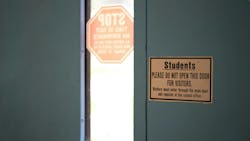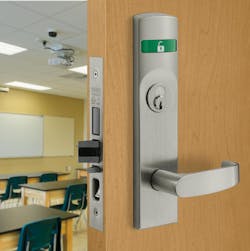This article originally appeared in the June 2024 issue of Security Business magazine. Don’t forget to mention Security Business magazine on LinkedIn and @SecBusinessMag on Twitter if you share it.
The Partner Alliance for Safer Schools (PASS) brings together expertise from the education, public safety and industry communities to develop and support a coordinated approach to making effective use of proven security practices specific to K-12 environments, and informed decisions on security investments.
By taking a layered approach to school security, PASS (www.passk12.org) addresses and provides recommendations for securing all areas of a school, from the perimeter to the individual classroom, with recommendations and best practices.
PASS Advisory Board Chair Guy Grace, who also serves as the K-12 National Security Program Manager for ASSA ABLOY, says controlling access is the first fundamental to securing the school environment. “We recommend considering electronic access control on more doors not only to expand building operations and daily school-business continuity, but also to facilitate emergency access in a more organized way,” he explains.
Exterior Access: A Mix of Electronic and Mechanical
While access control can consist of both mechanical and electronic systems, PASS recommends a limited number of key-operated openings should be provided to allow access to different areas of the property, parking lot, and building from the exterior if alternate access methods are required.
“Electronic access control is preferred, as electronics allow control to specific openings at specific times,” Grace explains, noting that emergency access through a card or credential device should be provided at multiple locations around the building, or at property and parking lot perimeters if secured, to ensure rapid access.
“Districts should provide access credentials to all emergency responders,” Grace adds. “One way this could be accomplished is by issuing all area law enforcement officers a key card or key fob that would access the currently installed card readers. Many school districts have found issuing law enforcement credentials to be very valuable in helping respond to emergencies on campuses. With that in mind, I would recommend that as card readers are replaced or updated, a mobile credential capability is considered.”
Grace adds that it is “absolutely critical” that first responders can get into the school, not just through one point, but through multiple points.
Classroom Locks
Whether mechanical or electronic locks are installed in classrooms, shelter-in-place, or interior openings, the interior doors should comply with appropriate locally enforced building codes for new educational occupancies, existing educational occupancies, new/existing daycare occupancies, new/existing business occupancies, and the Americans with Disabilities Act (ADA), according to latest PASS guidelines. The guidelines also recommend school administrators work with local integrators and/or life safety experts to determine code compliance related to securing classroom/interior doors.
While many types of mechanical and electronic locks are available, PASS notes that certain functionality is essential for classroom and other shelter-in-place doors from a safety and security standpoint, including:
- Classroom locks should be lockable from the inside of the room.
- Any lock shall allow keyed or electronic access from the corridor side for access by authorized personnel without a special tool or knowledge. Electronic access doors shall have a key override from the corridor side.
- Any lock shall always allow free egress from the inside of the room with one releasing operation.
- Locks should ideally have a visual indicator so that the condition of the lock (locked or unlocked) is visible from inside the room.
Note: Code-compliant conversion kits that retrofit existing locks with a visual indicator are an affordable means to comply with this recommendation, according to PASS.
“Giving any occupant the ability to lock that door is actually a critical piece now,” Grace says. “A new component is the visual indicators on locks – that's a life-saver, and it is also a culture enhancement within the schools. Indicator locks are now a ‘Tier 2’ item in our PASS guidelines – so we recommend K-12 to look at obtaining locks with visual indicators.”
Grace adds that many of these new PASS recommendations may be expensive, “but if this is done right, these are going to last generations and generations of kids,” he says. “You see a lot of our K-12 schools asking for these visual indicators because really it is about empowerment and peace of mind.”
Unified Security
Many schools are moving toward unifying all life safety systems, as these systems are being used daily within the school and classrooms and not just for an emergency.
“When you look at all of these components and recommendations, it is quite evident that they are foundational components,” Grace says. “Our next recommendation is [unifying] life safety systems – for example, lockdown, mass notification, video surveillance, public address, first-responder, and real-time location services.”
The unification piece is a big takeaway for integrators as they specify, design and install systems. “It is about all those technologies working together,” Grace says. “Having all technology unified in a way to [enable responders to] get real-time tactical information about what is going on, the location, and speedier access is critically important,” Grace explains. “For example, when first responders look at school maps during an incident, it could be very perplexing, especially for larger facilities.”
The ability to access schools quickly and efficiently using location services and strategic access points cuts down on response time as well as provides the ability to segregate or localize an attack,” Grace says. “[Now] you have stopped, deterred, or delayed an adversary from getting to different areas in a school. You are also tactically cutting down response time for a medical or first responder emergency.”
Many large schools, campuses, and districts are also establishing security operations centers (SOCs), with states like Texas looking at adding them state-wide.
“Many school districts with more than 7,000 students are creating SOCs like what we had in Littleton,” notes Grace, who previously served as Director of Security and Emergency Planning for Littleton Public Schools, a suburb of Denver. “Texas is building security operations centers for all its regions, with many of those school districts building their own – everything is unified.”
Educating the Educators
As an industry, Grace says we need to continue to empower all stakeholders in those K-12 schools.
“We are trying to provide [school administrators] what they need to know to be able to deal with emergencies daily,” he says. “We need to continue to work on that empowerment piece and do anything we can to educate kids and teachers [about what to do in] emergencies. Obviously, there are so many things that need to be done, but when you give people confidence, it goes a long way toward their overall mental health – whether that be via technology, or defining roles, processes, and implementations.”
Lockdown Drills
4 tips to help school end-users create this vital aspect of K-12 safety
Creating a lockdown drill procedure requires careful and thoughtful planning. It is crucial to consider the possible effects of drills on the mental well-being of students and teachers. “Making any drill an educational experience for the staff, students, and community is important,” says Grace. “Students should be empowered to know what to do.”
Here are essential steps to develop an efficient lockdown drill, which can also be found in the PASS Safety and Security Guidelines (www.passk12.org).
1. Notify parents in advance: Transparency is key. Parents should be informed well in advance about drills, allowing them to discuss the process with their children and address any concerns.
2. Test systems when schools are closed: It is essential to regularly test a school’s communication systems, alarms, and security measures during breaks or when they are closed. Specifically, it is essential to check door locks, sensors, monitoring systems, and emergency messaging systems.
3. Keep drills simple and age-appropriate: A well-understood plan that is easy to follow will lead to a more effective response. It is important to balance the need for preparedness with sensitivity to the students’ developmental stage. Safe and Sound Schools (https://safeandsoundschools.org) offers guidance on understanding students’ development levels, which can help craft an age-appropriate drill procedure.
3. Offer multiple strategies/scenarios: It is important to note that students and staff may not always be in their classrooms or behind closed doors. In an active threat situation, the natural human reaction is to be startled, feel fear and anxiety, and even experience initial disbelief and denial. Knowing your options provides the means to regain composure, recall at least some of what you have learned, and commit to action.
There are four consistent basic options that you can utilize: shelter, evade, defend, and care. During an active threat, individuals rarely have all the information they need to make a fully informed decision about which option is best; therefore, it is necessary to teach them additional strategies beyond just sheltering in a classroom. For instance, they should be taught what to do when an active threat arises in other areas of the school, such as bathrooms, cafeterias, or hallways. In addition, during a lockdown drill at an elementary school, staff and students should be given scenarios for recess so they can learn how to leave school grounds safely.
4. Make it an educational experience: Transform drills into educational opportunities by discussing the importance of preparedness, the rationale behind each action (like shutting off lights, staying quiet and out of view, and responding to law enforcement), and everyone’s responsibility to maintain a secure environment.
About the Author

Paul Ragusa
Paul Ragusa is senior editor for Locksmith Ledger International, an Endeavor Business Media Security publication.

![“Having all technology unified in a way to [enable responders to] get real-time tactical information about what is going on, the location, and speedier access is critically important.” - Guy Grace “Having all technology unified in a way to [enable responders to] get real-time tactical information about what is going on, the location, and speedier access is critically important.” - Guy Grace](https://img.securityinfowatch.com/files/base/cygnus/siw/image/2024/05/665747dd03781342e89f50ae-guy_2023_zero.png?auto=format,compress&fit=max&q=45?w=250&width=250)
